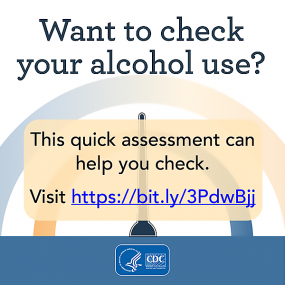Excessive Alcohol Use is a Risk to Men’s Health
Men are more likely than women to drink excessively.1 Excessive drinking is associated with significant risks to men’s health and safety, and the risks increase with the amount of alcohol consumed. Men are also more likely than women to take other risks (such as misusing other substances, having multiple sex partners, or not wearing a seat belt), that when combined with alcohol, further increase their risk of illness, injury or death.2-5

Adult Men Drink More than Women
- Almost 58% of adult men report drinking alcohol in the past 30 days compared with 49% of adult women.1
- Men are more likely to binge drink than women. Approximately 21% of men report binge drinking, compared with 13% of women. Among men who binge drink, 25% do so at least five times a month, on average, and 25% consume at least nine drinks during a binge drinking occasion.1
- In 2020, 13% of adult men had an alcohol use disorder compared with 9% of adult women.2
Alcohol is Associated with Injury, Violence, and Other Harms
- Men have higher rates of alcohol-related hospitalizations than women.6
- About two-thirds of deaths from excessive drinking are among males, totaling nearly 120,000 deaths each year in the U.S.7
- Among drivers in fatal motor vehicle traffic crashes, men are 50% more likely to have been intoxicated (i.e., a blood alcohol concentration of 0.08% or greater) compared with women.8
- Excessive alcohol consumption increases aggression and may increase the risk of physically assaulting another person.9 Alcohol is a key risk factor for sexual violence perpetration.10
- Males are more than three times as likely to die by suicide than females, and more likely to have been drinking prior to suicide.11-13
- Alcohol use is one of the most important preventable risk factors for cancer.14 Alcohol use increases the risk of cancer of the mouth, throat, esophagus, liver, and colon, which are more common among men.14,15 Drinking alcohol also increases the risk of prostate cancer.16
Alcohol May Affect Men’s Sexual and Reproductive Health
- Excessive alcohol use can interfere with testicular function and male hormone production resulting in erectile dysfunction and infertility.17
- Alcohol use by men also increases the chances of engaging in risky sexual activity including unprotected sex, sex with multiple partners, or sex with a partner at risk for sexually transmitted infections.18,19
Men can reduce the amount of alcohol they drink to reduce their risk of health problems and other harms.
The Alcohol Use and Your Health Fact Sheet addresses a number of additional health conditions associated with excessive alcohol use that affect both men and women.
-
- Centers for Disease Control and Prevention. Behavioral Risk Factor Surveillance System.
- Substance Abuse and Mental Health Services Administration. Results from the 2020 National Survey on Drug Use and Health: Detailed Tables. Rockville, MD: 2021.
- Tori ME, Larochelle MR, Naimi TS. Alcohol or benzodiazepine co-involvement with opioid overdose deaths in the United States, 1999-2017. JAMA Netw Open 2020;3:e202361.
- Centers for Disease Control and Prevention. Key Statistics from the National Survey of Family Growth website. Accessed April 19, 2022.
- Beck LF, Downs J, Stevens MR, Sauber-Schatz EK. Rural and urban differences in passenger-vehicle–occupant deaths and seat belt use among adults — United States, 2014. MMWR 17;66:1–13.
- Chen CM, Yoon Y. Trends in alcohol-related morbidity among community hospital discharges, United States, 2000-2015. Bethesda, MD: National Institutes of Health, National Institute on Alcohol Abuse and Alcoholism, 2018.
- Centers for Disease Control and Prevention. Alcohol-Related Disease Impact Application website. Accessed February 29, 2024.
- National Highway Traffic Safety Administration. Traffic Safety Facts Annual Report Tables – 2018. Washington, DC: NHTSA, 2019.
- Crane CA, Godleski SA, Przybyla SM, Schlauch RC, Testa M. The proximal effects of acute alcohol consumption on male-to-female aggression: A meta-analytic review of the experimental literature. Trauma Violence Abuse 2016;17:520–531.
- Abbey A, Wegner R, Woerner J, Pegram SE, Pierce J. Review of survey and experimental research that examines the relationship between alcohol consumption and men’s sexual aggression perpetration. Trauma Violence Abuse 2014;15:265–282.
- Stone DM, Simon TR, Fowler KA, et al. Vital Signs: Trends in state suicide rates – United States, 1999–2016 and circumstances contributing to suicide – 27 states, 2015. MMWR Morb Mortal Wkly Rep 2018;67:617–624.
- Kaplan MS, Huguet N, McFarland BH, Caetano R, et al. Use of alcohol before suicide in the United States. Ann Epidemiol 2014;24:588–592.e1–2.
- Borges G, Bagge CL, Cherpitel CJ, Conner KR. A meta-analysis of acute use of alcohol and the risk of suicide attempt. Psych Med 2017;47:949–957.
- American Cancer Society. Alcohol use and cancer website. Accessed October 31, 2022.
- Rehm J, Shield KD, Weiderpass E. Alcohol Consumption: A Leading Risk Factor for Cancer. In: Wild CP, Weiderpass E, Stewart BW, eds. World Cancer Report. Lyon, France: International Agency for Research on Cancer; 2020:68–76.
- Zhao J, Stockwell T, Roemer A, Chikritzhs T. Is alcohol consumption a risk factor for prostate cancer? A systematic review and meta-analysis. BMC Cancer 2016;16:845.
- Rachdaoui N, Sarkar DK. Pathophysiology of the effects of alcohol abuse on the endocrine system. Alcohol Res 2017;38:255–276.
- Centers for Disease Control and Prevention. Staying Healthy and Preventing STDs website. Accessed October 31, 2022.
- Chandra A, Billioux VG, Copen CE, Sionean C. HIV risk-related behaviors in the United States household population aged 15-44 years: data from the National Survey of Family Growth, 2002 and 2006-2010. Hyattsville, MD: CDC, 2012.
